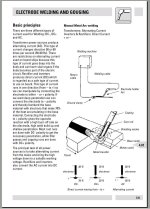I think you got something backwards in here.
If DCEP has the most pen, shouldn't the heat be 67% into the work? And vice versa for DCEN?.
Nope not backwards, but you are welcome to prove me wrong as I am far from an expert and have never claimed to be anything other than a hack welder.
Really it is simply a matter of perspective:
First In the mechanical world:
a) a 67 pound hammer hitting a center punch will leave the biggest divot in metal.
b) a 50 pound hammer swung at same speed will leave a medium sized center punch divot in the metal
c) a 33 pound hammer swung at same speed will leave the the smallest center punch divot in metal.
Now in the electrical world.
a) DCEP will put 67% of the heat, oomph, power( whatever you want to call it) into the stinger and it will leave the biggest divot in the metal.
b) AC will put 50% of the heat, oomph, power (again whatever you want to call it) into the stinger and it will leave the medium sized divot in the metal.
c) DCEN will put 33% of the heat, ooph, power (again whatever you want to call it) into the stinger and it will leave the smallest divot in the metal.
(NOTE: In the electrical world there are not any signifigant mechanical losses like friction found in the physical world so the leftover heat is transferred to the workpiece as them amps do not just magically disappear - they have to go someplace).


